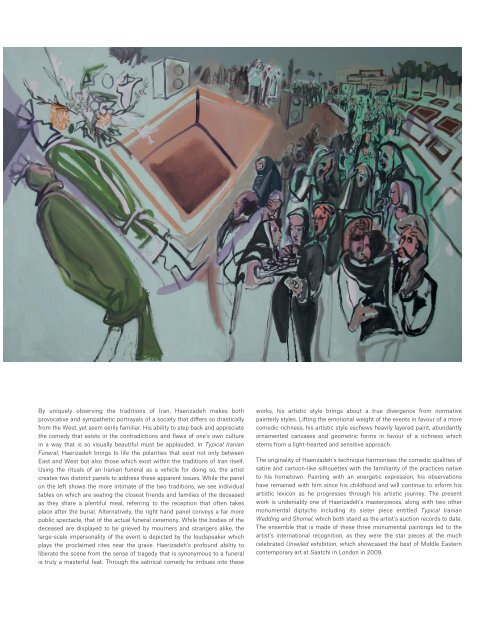NOW AND TEN
DUB1241_SaleCat
DUB1241_SaleCat
You also want an ePaper? Increase the reach of your titles
YUMPU automatically turns print PDFs into web optimized ePapers that Google loves.
By uniquely observing the traditions of Iran, Haerizadeh makes both<br />
provocative and sympathetic portrayals of a society that difers so drastically<br />
from the West, yet seem eerily familiar. His ability to step back and appreciate<br />
the comedy that exists in the contradictions and faws of one’s own culture<br />
in a way that is so visually beautiful must be applauded. In Typical Iranian<br />
Funeral, Haerizadeh brings to life the polarities that exist not only between<br />
East and West but also those which exist within the traditions of Iran itself.<br />
Using the rituals of an Iranian funeral as a vehicle for doing so, the artist<br />
creates two distinct panels to address these apparent issues. While the panel<br />
on the left shows the more intimate of the two traditions, we see individual<br />
tables on which are seating the closest friends and families of the deceased<br />
as they share a plentiful meal, referring to the reception that often takes<br />
place after the burial. Alternatively, the right hand panel conveys a far more<br />
public spectacle, that of the actual funeral ceremony. While the bodies of the<br />
deceased are displayed to be grieved by mourners and strangers alike, the<br />
large-scale impersonality of the event is depicted by the loudspeaker which<br />
plays the proclaimed rites near the grave. Haerizadeh’s profound ability to<br />
liberate the scene from the sense of tragedy that is synonymous to a funeral<br />
is truly a masterful feat. Through the satirical comedy he imbues into these<br />
works, his artistic style brings about a true divergence from normative<br />
painterly styles. Lifting the emotional weight of the events in favour of a more<br />
comedic richness, his artistic style eschews heavily layered paint, abundantly<br />
ornamented canvases and geometric forms in favour of a richness which<br />
stems from a light-hearted and sensitive approach.<br />
The originality of Haerizadeh’s technique harmonises the comedic qualities of<br />
satire and cartoon-like silhouettes with the familiarity of the practices native<br />
to his hometown. Painting with an energetic expression, his observations<br />
have remained with him since his childhood and will continue to inform his<br />
artistic lexicon as he progresses through his artistic journey. The present<br />
work is undeniably one of Haerizadeh’s masterpieces, along with two other<br />
monumental diptychs including its sister piece entitled Typical Iranian<br />
Wedding and Shomal, which both stand as the artist’s auction records to date.<br />
The ensemble that is made of these three monumental paintings led to the<br />
artist’s international recognition, as they were the star pieces at the much<br />
celebrated Unveiled exhibition, which showcased the best of Middle Eastern<br />
contemporary art at Saatchi in London in 2009.


